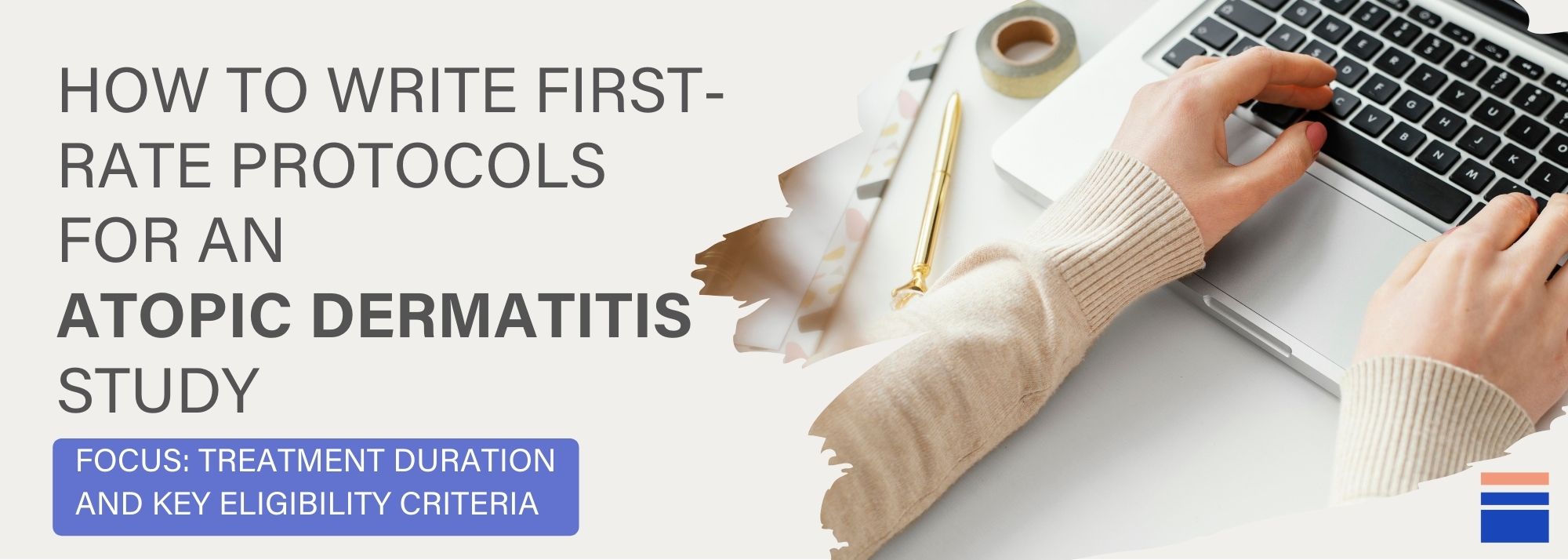How to Write First-Rate Protocols for an Atopic Dermatitis Study - Focus: TREATMENT DURATION AND KEY ELIGIBILITY CRITERIA

In recent years, therapeutics for dermatologic conditions have become a subspecialty of growing interest in the Clinical Research Organisation (CRO) industry, with clinical research in the area focused on a wide range of skin indications, such as acne vulgaris, psoriasis, and atopic dermatitis.
What is atopic dermatitis?
Atopic dermatitis (AD), also known as atopic eczema, is the most common, long-term type of inflammatory skin disease. Stemming from skin barrier dysfunction, immune alterations, and/or genetic and environmental factors, the condition may occur at any age but usually starts in childhood.
Treatment duration in AD trials: 4-8 weeks
Writing a first-rate protocol for a study on AD entails defining the dosage of the study drug as well as the duration of treatment. In AD trials, the duration should be between 4 and 8 weeks, which is relatively short.
The results of clinical studies suggest greater differences between the active and control groups between 4 and 8 weeks of treatment compared to shorter or longer periods.
In a Phase 2b study in which Innovaderm participated, there was a greater difference in the change from baseline in Eczema Area and Severity Index (EASI) between the active and placebo groups at Weeks 4, 6, and 8 compared to Week 12.

Key eligibility criteria
Once the study has been designed, the next step is to describe the desired study population with eligibility criteria. A protocol usually contains 10 to 30 eligibility criteria.
First, the disease severity should be clearly defined. In addition, since AD is a highly fluctuating condition, disease severity criteria must be met at both screening and baseline.
The use of emollients – except those containing urea, which have shown efficacy in treating AD – should be allowed in AD trials, but the application frequency should be controlled. While the frequency of emollient application can be established in the protocol, the use of emollients in AD trial may lead to numerous protocol deviations, especially in patients who suffer from hand eczema and who must use moisturizers multiple times throughout the day. To prevent this, protocols in AD should be written in a way that offers flexibility. For example, they can state that emollients should be employed for a certain period prior to Day 1 and at the same frequency during the study.
It is also critical to prohibit the use of certain procedures and medications such as antihistamines that cause somnolence because they can impact itch, the hallmark symptom of AD.
Finally, since AD can be influenced by several external factors, a few lifestyle restrictions should also be put into place. For example, when conducting a study that involves a topical agent, it is important to consider the subject’s exercise activities and bathing routine as these may impact treatment absorption and ultimately, treatment efficacy.
Conclusion
When writing an AD protocol, you must not only have a solid understanding of the indication and what you are measuring, but also keep abreast of related literature. Be it procedures for a study on AD or another skin indication, the best protocols in dermatology are often the simplest, with the goal of bridging a knowledge gap or highlighting something new in the field. Resulting from a strong collaborative effort, a first-rate protocol not only provides a roadmap for better enrollment rates and data quality, but also allows investigators to remain at the forefront of dermatology research.
About the Author
Stéphanie Légaré is a senior clinical scientist at Innovaderm with >10 years’ experience in scientific and medical communication and translational/clinical research. Throughout her career, she has managed several investigator-initiated studies and developed training materials for pharmaceutical and life sciences companies.
✨ To learn best tips for writing about study design for research on AD, click here.
✨ To learn best tips for writing about clinical assessments and types of endpoints for a study on AD, click here.
✨ For more great tips, watch our webinar on the Art of Protocol Writing in Dermatology.
***
Want to ensure your study is a great success? Contact us today to partner with our expert team of clinical trial professionals.
Newsletter
Newsletter subscription resources

